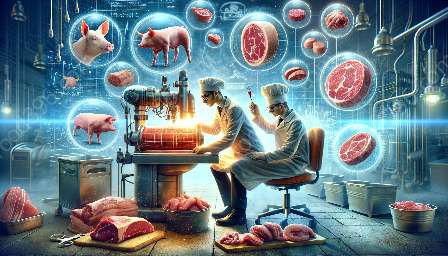Welcome to the wonderful world of meat roasting where the art of cooking meets the science of meat processing. Discover the essential techniques, methods, and principles of meat roasting while unraveling the fascinating insights of meat science.
The Roasting Process
Roasting meat is a time-honored cooking method that has been practiced for centuries. The process involves cooking meat using dry heat, typically in an oven, over an open flame, or with the use of specialized roasting equipment.
Meat Selection
The first step in meat roasting is selecting the right type and cut of meat. While popular choices include beef, lamb, and pork, the roasting process can be applied to various types of meat such as poultry and game. The cut of meat also plays a crucial role, with options ranging from prime rib and tenderloin to brisket and shoulder.
Seasoning and Flavoring
Before roasting, the meat is often seasoned and flavored to enhance its taste and texture. Common ingredients for seasoning meat include salt, pepper, herbs, spices, and aromatic substances like garlic and onions. The choice of seasoning can complement the natural flavor of the meat and create a symphony of tastes and aromas.
Roasting Methods
When it comes to roasting, there are several methods to consider, each offering unique advantages and potential flavor profiles. These methods include dry roasting, spit roasting, and rotisserie cooking. The choice of method can depend on the type of meat and desired outcome, whether it be a tender, juicy roast or a caramelized, crispy exterior.
Temperature and Timing
Controlling the temperature and timing is crucial for achieving the perfect roast. Different cuts and types of meat require precise temperature settings and cooking durations to ensure optimal results. Meat thermometers are often used to monitor the internal temperature of the roast, allowing for precise and consistent cooking.
Meat Processing
Meat roasting is closely linked to the broader field of meat processing, which involves various techniques for transforming raw meat into a wide range of products. From curing and smoking to grinding and aging, meat processing encompasses a diverse array of methods designed to enhance flavor, shelf life, and safety of meat products.
Curing and Brining
Curing and brining are common meat processing techniques that can also influence the outcome of roasted meats. Curing involves the use of salts and seasonings to preserve and flavor meats, while brining uses saltwater solutions to tenderize and infuse flavors into the meat. These methods can be employed prior to roasting to add complexity and depth to the final dish.
Smoking and Barbecuing
The art of smoking and barbecuing meats is an integral part of meat processing, with techniques that impart rich flavors through the use of wood smoke and slow cooking. Whether it's traditional wood-fired smoking or modern electric smoking, these methods can greatly enhance the taste of roasted meats, creating a harmonious blend of smokiness and succulence.
Grinding and Forming
Meat processing also involves grinding and forming techniques that can be applied before roasting. Ground meats can be seasoned, shaped, and formed into various roastable products such as meatloaf, patties, and sausages, offering a versatile approach to meat roasting.
Aging and Tenderizing
Aging and tenderizing meat are essential processes in meat processing that can influence the tenderness and flavor of roasts. Dry aging and enzymatic tenderization methods can transform tougher cuts of meat into delectably tender roasts, elevating the overall dining experience.
Meat Science
Meat roasting intertwines with the principles of meat science, a field that delves into the biology, chemistry, and physics of meat. Understanding the fundamental aspects of meat science can provide valuable insights into the behavior of meat during roasting and the factors that contribute to its sensory qualities.
Protein Denaturation and Maillard Reaction
During roasting, proteins in the meat undergo denaturation, a process wherein protein structures change in response to heat. This transformation contributes to the texture and juiciness of the roast. Additionally, the Maillard reaction, a complex chemical process between amino acids and reducing sugars, occurs during roasting, resulting in the desirable browning and flavor development of the meat's surface.
Heat Transfer and Moisture Loss
Understanding heat transfer and moisture loss in meat is crucial for achieving optimal roasting results. The principles of conduction, convection, and radiation play a role in how heat is transferred to the meat, influencing its internal temperature and overall doneness. Moreover, managing moisture loss during roasting is vital for maintaining the succulence and juiciness of the meat.
Flavor Development and Aromatics
Meat science explores the intricate interplay of flavors and aromatics that develop during roasting. The composition of aromatic compounds, such as aldehydes, ketones, and esters, contributes to the unique scent and taste of roasted meats, adding depth and complexity to the dining experience.
Tenderness and Texture Analysis
Meat scientists employ various techniques to assess the tenderness and texture of roasted meats. These analyses involve sensory evaluation, instrumental measurements, and structural examinations to understand the mechanical properties and eating qualities of the roast, providing valuable feedback for optimizing the roasting process.
Conclusion
Meat roasting embodies a perfect harmony of culinary artistry and scientific understanding. By delving into the intricacies of the roasting process, its compatibility with meat processing, and the insights of meat science, you can elevate your expertise and appreciation for the flavorful world of roasted meats. Embrace the art and science of meat roasting and savor the rewarding journey of creating delectable roasts that captivate the senses and delight the palate.

